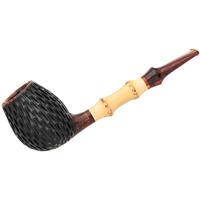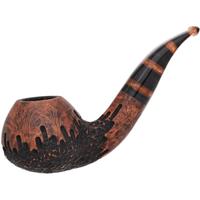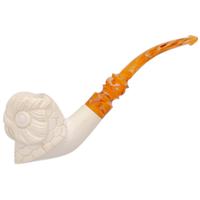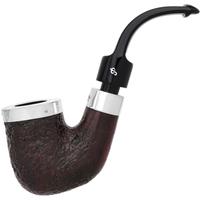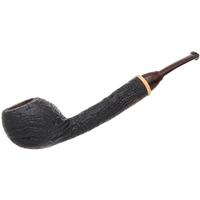A different slant to this conversation:
Weights are often added to online pipe listings as a way of judging quality, with heavier being generally preferred.
This is my experience, anyway, after restoring a few hundred estates and selling my own pipes.
All the (admittedly impressive) talk of density, porousness, etc. aside, when buying something based solely on pictures, people want to know if the pipe is substantial. That doesn't necessarily mean disproportionately heavy or poorly weighted. But when you're thinking of buying a 60s era Sasieni chimney form, you don't want it to weigh 25g. That would mean either the pipe is burned out from someone smoking it too hot, or the walls were made too thin in the first place.
None of that speaks to weight relative to smoking qualities.
Just wanted to point out that the reason weight is often listed is because people want a non-graphic measure of the product they are buying.
Also. . .my $.02 on a couple other topics that have been raised:
- grain has very little to do with smoking properties. Proof? Take a look at some 50s/60s Dunhills. They're known as some of the best smokers of all time, and cost a fortune today. Charatan used to make fun of the grains on Dunhills in their advertisements. That's how non-uniform the graining could be.
- I think it would be difficult to find a pipe maker who worked with wet briar. It's just not done. I don't even know where you could buy green briar blocks. When you see big racks of briar in someone workshop, it's not because they are aging the wood (unless we're talking Savinelli or something, in which case there are warehouses for aging), but because they bought in bulk at one point, and like going through 200 blocks to find just the right one for whatever form they're about to build.
Weights are often added to online pipe listings as a way of judging quality, with heavier being generally preferred.
This is my experience, anyway, after restoring a few hundred estates and selling my own pipes.
All the (admittedly impressive) talk of density, porousness, etc. aside, when buying something based solely on pictures, people want to know if the pipe is substantial. That doesn't necessarily mean disproportionately heavy or poorly weighted. But when you're thinking of buying a 60s era Sasieni chimney form, you don't want it to weigh 25g. That would mean either the pipe is burned out from someone smoking it too hot, or the walls were made too thin in the first place.
None of that speaks to weight relative to smoking qualities.
Just wanted to point out that the reason weight is often listed is because people want a non-graphic measure of the product they are buying.
Also. . .my $.02 on a couple other topics that have been raised:
- grain has very little to do with smoking properties. Proof? Take a look at some 50s/60s Dunhills. They're known as some of the best smokers of all time, and cost a fortune today. Charatan used to make fun of the grains on Dunhills in their advertisements. That's how non-uniform the graining could be.
- I think it would be difficult to find a pipe maker who worked with wet briar. It's just not done. I don't even know where you could buy green briar blocks. When you see big racks of briar in someone workshop, it's not because they are aging the wood (unless we're talking Savinelli or something, in which case there are warehouses for aging), but because they bought in bulk at one point, and like going through 200 blocks to find just the right one for whatever form they're about to build.



